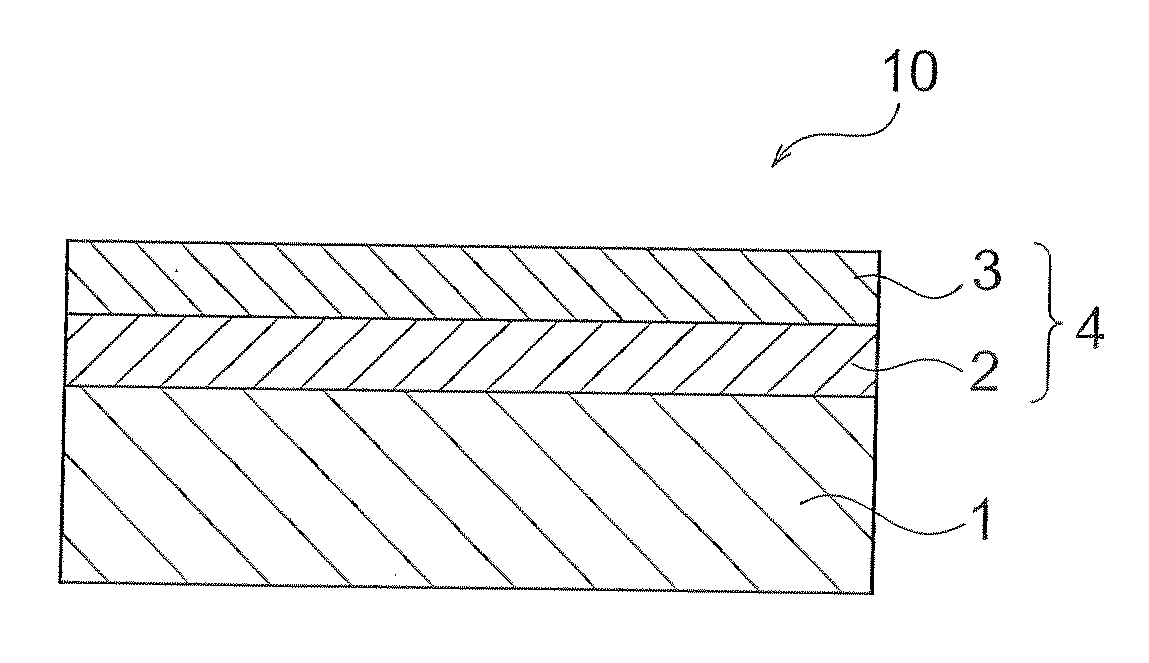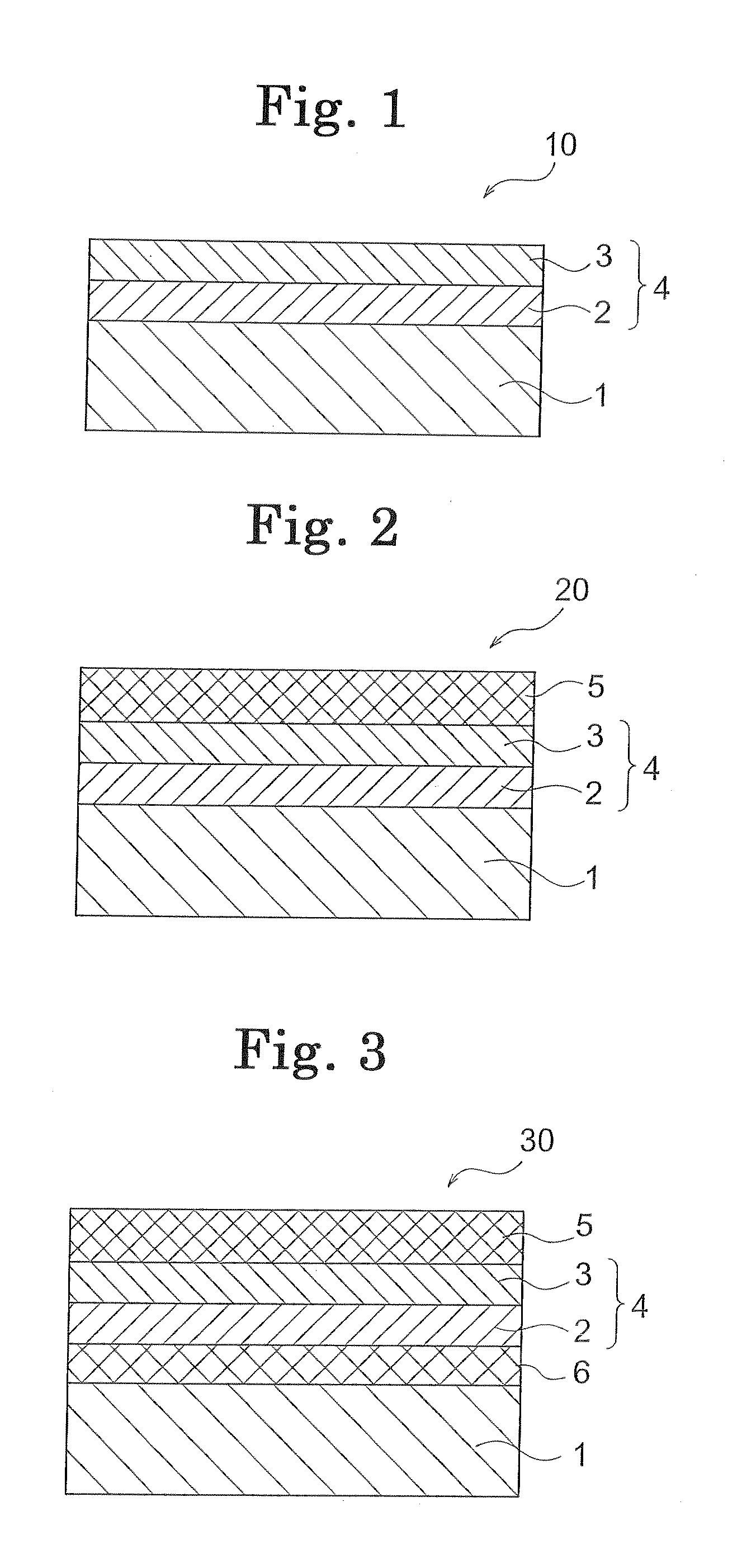Member for masking film, process for producing masking film using the same, and process for producing photosensitive resin printing plate
a technology of resin printing plate and masking film, which is applied in the direction of photomechanical treatment, microlithography exposure apparatus, instruments, etc., can solve the problems of poor resolution, complex operation, and inability to deal with large-sized masking films, and achieve uniform light transmittance, maintain abrasion resistance and adhesion, and excellent production stability of ultraviolet-shielding resin layer.
- Summary
- Abstract
- Description
- Claims
- Application Information
AI Technical Summary
Benefits of technology
Problems solved by technology
Method used
Image
Examples
example 1
[0095]To one surface of a polyethylene terephthalate (PET) film having a thickness of 125 μm and a haze value of 0.95% [trade name “COSMOSHINE A4100”, manufactured by Toyobo Co., Ltd.], a carbon-black-containing resin liquid (A) [resin component: vinyl chloride / vinyl acetate copolymer having a Tg of not less than 40° C., carbon black average particle size: 24 nm, specific surface area: 115 g / m2, carbon black / resin content mass ratio: 1.61 / 1] was applied to an average dry thickness of 2.0 μm, followed by drying to form a layer (A). Then, onto the layer (A), a carbon-black-containing resin liquid (B) [resin component: vinyl chloride / vinyl acetate copolymer having a Tg of not less than 40° C., carbon black average particle size: 24 nm, specific surface area: 115 g / m2, carbon black / resin content mass ratio: 0.85 / 1, silica filler: 8 mass %] was applied to an average dry thickness of 0.5 μm, followed by drying to form a layer (B). An ultraviolet-shielding resin layer was thus formed, ther...
example 2
[0096]To one surface of a PET film having a thickness of 125 μm and a haze value of 0.95% (mentioned above), carbon-black-containing resin liquid (A) [resin component: acrylic resin having a Tg of not less than 40° C. with 32 mass % of a hexamethylene-diisocyanate (HDI)-based isocyanate crosslinking agent added thereto, carbon black average particle size: 24 nm, specific surface area: 115 g / m2, carbon black / resin content mass ratio: 1.36 / 1, silica filler added in an amount of 10 mass %] was applied to an average dry thickness of 2.0 μm, followed by drying to form a layer (A). Then, onto the layer (A), a carbon-black-containing resin liquid (B) [resin component: acrylic resin having a Tg of not less than 40° C. with 59 mass % of an HDI-based isocyanate crosslinking agent added thereto, carbon black average particle size: 24 nm, specific surface area: 115 q / m2, carbon black / resin content mass ratio: 0.83 / 1, silica filler: 8 mass % j was applied to an average dry thickness of 0.5 μM, f...
example 3
[0097]To one surface of a PET film having a thickness of 125 μm and a haze value of 0.95% (mentioned above), carbon-black-containing resin liquid (A) [resin component: acrylic resin having a Tg of not less than 40° C. with 32 mass % of an HDI-based isocyanate crosslinking agent added thereto, carbon black average particle size: 24 nm, specific surface area: 115 g / m2, carbon black / resin content mass ratio: 1.36 / 1, silica filler added in an amount of 10 mass %] was applied to an average dry thickness of 2.0 μm, followed by drying to form a layer (A). Then, onto the layer (A), carbon-black-containing resin liquid (B) [resin component: acrylic resin having a Tg of not less than 40° C. with 59 mass % of an HDI-based isocyanate crosslinking agent added thereto, carbon black average particle size: 24 nm, specific surface area: 115 g / m2, carbon black / resin content mass ratio: 0.83 / 1, silica filler: 8 mass %] was applied to an average dry thickness of 0.5 μm, followed by drying to form a lay...
PUM
| Property | Measurement | Unit |
|---|---|---|
| thickness | aaaaa | aaaaa |
| wavelength | aaaaa | aaaaa |
| ultraviolet transmittance | aaaaa | aaaaa |
Abstract
Description
Claims
Application Information
 Login to View More
Login to View More - R&D
- Intellectual Property
- Life Sciences
- Materials
- Tech Scout
- Unparalleled Data Quality
- Higher Quality Content
- 60% Fewer Hallucinations
Browse by: Latest US Patents, China's latest patents, Technical Efficacy Thesaurus, Application Domain, Technology Topic, Popular Technical Reports.
© 2025 PatSnap. All rights reserved.Legal|Privacy policy|Modern Slavery Act Transparency Statement|Sitemap|About US| Contact US: help@patsnap.com


